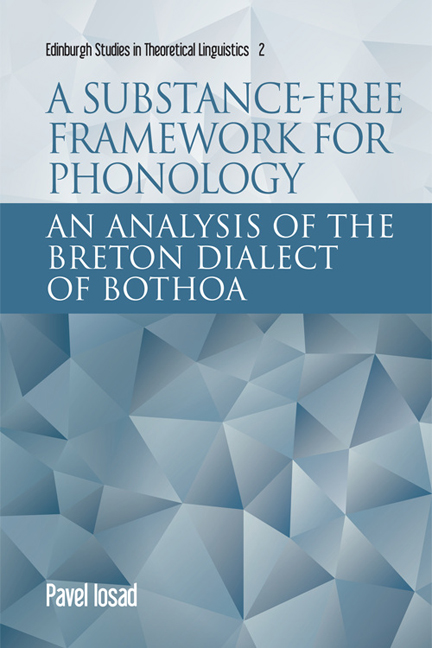Book contents
- Frontmatter
- Contents
- Acknowledgements
- Chapter 1 Introduction
- Chapter 2 Conceptual foundations of substance-free phonology
- Chapter 3 Representational assumptions
- Chapter 4 Computational assumptions
- Chapter 5 Complexity and markedness in substance-free phonology
- Chapter 6 The Breton language
- Chapter 7 Segments and representations
- Chapter 8 Suprasegmental phonology
- Chapter 9 The phonology of vowels
- Chapter 10 The phonology of consonants: palatalisation and gliding
- Chapter 11 Laryngeal phonology
- Chapter 12 Conclusion
- References
- Index
Chapter 2 - Conceptual foundations of substance-free phonology
Published online by Cambridge University Press: 20 December 2017
- Frontmatter
- Contents
- Acknowledgements
- Chapter 1 Introduction
- Chapter 2 Conceptual foundations of substance-free phonology
- Chapter 3 Representational assumptions
- Chapter 4 Computational assumptions
- Chapter 5 Complexity and markedness in substance-free phonology
- Chapter 6 The Breton language
- Chapter 7 Segments and representations
- Chapter 8 Suprasegmental phonology
- Chapter 9 The phonology of vowels
- Chapter 10 The phonology of consonants: palatalisation and gliding
- Chapter 11 Laryngeal phonology
- Chapter 12 Conclusion
- References
- Index
Summary
In this chapter I discuss the basic assumptions underlying the framework presented in this book and give a brief overview of the modular approach to grammar that provides the conceptual motivation for the theory.
The modular enterprise
At the heart of the substance-free approach is the thesis that phonology is an autonomous module; that it exists as a component of grammar and possesses domain-specific representational and computation systems that are, in principle, independent of the representational and computational systems operating in morphosyntax or phonetics. Arguably, in this view phonology must be substance-free almost by definition: in the classic modular approach (Fodor 1983), modules are defined by characteristics such as information encapsulation and domain specificity. If phonology is a module, then the alphabet of phonological symbols and the types of operations available for these symbols must be independent of considerations that properly belong to other domains, despite the fact that such considerations are often relevant to the shape of phonological systems.
The substance-free approach takes autonomy and modularity seriously, resting on the assumption that the phonological grammar operates independently of external factors, similarly to recent work by authors such as Reiss (2007); Scheer (2010); Bermúdez-Otero (2012). Specifically, phonology is defined as a module that effects categorical computation over proprietary phonological symbols. The focus in this book is on segmental phonology, so the majority of such symbols encountered here are phonological features.
With respect to the identification of features, I follow the main tenet of the Contrastivist Hypothesis as expressed in structuralist phonology (e.g. Trubetzkoy 1939; Martinet 1955; Hjelmslev 1975) and recently revived in the ‘Toronto school’ of contrastive specification (e.g. Dresher et al. 1994; Dresher 2003, 2009; Hall 2007; Mackenzie 2013). I operate with the assumption that the set of features available to a language's phonological grammar is coextensive with the set of features used to make distinctions among segments found in lexical (underlying) representations for that language's morphemes. In this formulation, the Contrastivist Hypothesis is arguably the default assumption for a minimalist conception of phonology: if a feature is necessary to express lexical contrast, its existence is justified ‘outside’ the phonological grammar, and therefore appealing to it in our analysis of phonological patterns does not require special pleading.
- Type
- Chapter
- Information
- A Substance-free Framework for PhonologyAn Analysis of the Breton Dialect of Bothoa, pp. 5 - 35Publisher: Edinburgh University PressPrint publication year: 2017



